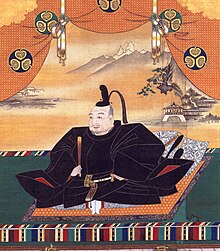Edo period (1603–1868)
The Edo, or Tokugawa period saw power centralized in the hands of a hereditary shogunate that took control of religion, regulated the entire economy, subordinated the nobility, and set up uniform systems of taxation, government spending and bureaucracies. It avoided international involvement and wars, established a national judiciary and suppressed protest and criticism. The Tokugawa era brought peace, and that brought prosperity to a nation of 31 million.
About 80% of the people were rice farmers. Rice production increased steadily, but population remained stable, so prosperity increased. Rice paddies grew from 1.6 million chō in 1600 to 3 million by 1720. Improved technology helped farmers control the all-important
flow of irrigation to their paddies. The daimyō operated several hundred castle towns, which became loci of domestic trade. Large-scale rice markets developed, centered on Edo and Ōsaka. In the cities and towns, guilds of merchants and artisans met the growing demand for goods and services. The merchants, while low in status, prospered, especially those with official patronage. Merchants invented credit instruments to transfer money, currency came into common use, and the strengthening credit market encouraged entrepreneurship.
Japanese society had an elaborate social structure, in which everyone knew their place and level of prestige. At the top were the emperor and the court nobility, invincible in prestige but weak in power. Next came the "bushi" of shōgun, daimyō and layers of feudal lords whose rank was indicated by their closeness to the Tokugawa. They had power. The "daimyō" comprised about 250 local lords of local "han" with annual outputs of 50,000 or more bushels of rice. The upper strata was much given to elaborate and expensive rituals, including elegant architecture, landscaped gardens, Noh drama, patronage of the arts, and the tea ceremony.
The lower social orders were divided into two main segments—the peasants—80% of the population—whose high prestige as producers was undercut by their burden as the chief source of taxes. They were illiterate and lived in villages controlled by appointed officials who kept the peace and collected taxes. Peasants and villagers frequently engaged in unlawful and disruptive protests, especially after 1780
During the early part of the 17th century, the shogunate suspected that foreign traders and missionaries were actually forerunners of a military conquest by European powers. Christianity had spread in Japan, especially among peasants, and the shogunate suspected the loyalty of Christian peasants towards their daimyō, severely persecuting them. This led to a revolt by persecuted peasants and Christians in 1637 known as the Shimabara Rebellion which saw 30,000 Christians, rōnin, and peasants facing a massive samurai army of more than 100,000 sent from Edo. The rebellion was crushed at a high cost to the shōgun's army.
Beginning in 1868, Japan undertook political, economic, and cultural transformations emerging as a unified and centralized state, the Empire of Japan (also Imperial Japan or Prewar Japan). This 77-year period, which lasted until 1945, was a time of rapid economic growth. Japan became an imperial power, colonizing Korea andTaiwan. Starting in 1931 it began the takeover of Manchuria and China, in defiance of the League of Nations and the United States. Escalating tension with the U.S.--and western control of Japan's vital oil supplies—led to World War II. Japan launched multiple successful attacks on the U.S. as well as British and Dutch territories in 1941–42. After a series of great naval battles, the Americans sank the Japanese fleet and largely destroyed 50 of its largest cities through air raids, including nuclear attacks on Hiroshima and Nagasaki. Japan surrendered in late summer 1945, gave up its overseas holdings in Korea, China, Taiwan and elsewhere, and was occupied and transformed into a demilitarized democratic nation by the U.S..
Childhood as a distinct phase of life was apparent in the early modern period, when social and economic changes brought increased attention to children, the growth of schooling and child-centered rituals. A modern concept of childhood emerged in Japan after 1850 as part of its engagement with the West. Meiji era leaders decided the nation-state had the primary role in mobilizing individuals – and children – in service of the state. The Western-style school was introduced as the agent to reach that goal. By the 1890s, schools were generating new sensibilities regarding childhood. After 1890 Japan had numerous reformers, child experts, magazine editors, and well-educated mothers who bought into the new sensibility. They taught the upper middle class a model of childhood that included children having their own space where they read children's books, played with educational toys and, especially, devoted enormous time to school homework. These ideas rapidly disseminated through all social classes.
